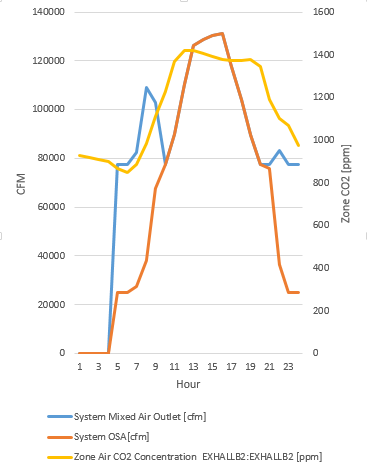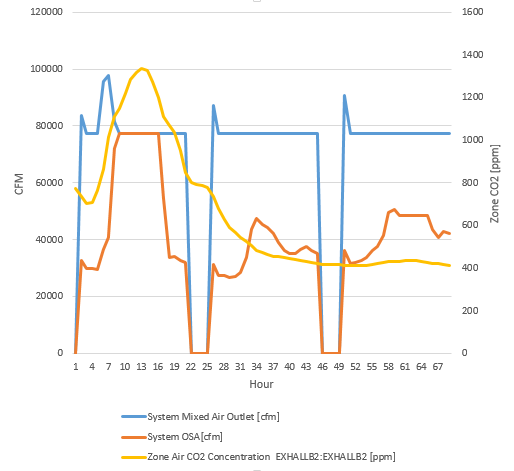In Energy Plus, I am using the Indoor Air Quality (Contaminant concentration modeling) approach to simulate DCV. The zone CO2 setpoint of 1100 ppm is not met. Below are graphs for one system, showing a "high" occupancy day in the first graph, and a "normal" occupancy day followed by two "low" occupancy days in the second graph; system cfm flow is plotted the left axis (blue = mixed air, orange = outside air) and zone C02 ppm (yellow) on the right axis. Looking at these it seems to me that although the zone CO2 setpoint is not met, the system airflow will not increase above what would be provided for space conditioning. On the "normal" day graph, the outside air (orange) is capped at the system minimum flow rate (sum of all connected terminal min flows). On the "high" day graph, the system flow increases above the system minimum, but this seems to be driven by space load rather than by CO2 concentration, as the zone CO2 setpoint is still not met.


I found this post that I think is related, regarding using EMS to increase zone flow due to CO2 concentration. Is EMS the only way to do this?
As requested, here are some representative objects related to the DCV setup from my file:
DesignSpecification:OutdoorAir,
Exhall_OA, !- Name
Sum, !- Outdoor Air Method
0.0031, !- Outdoor Air Flow per Person {m3/s-person}
0.0004; !- Outdoor Air Flow per Zone Floor Area {m3/s-m2}
ZoneControl:ContaminantController,
ExHallB2 DCV, !- Name
ExHallB2:ExHallB2, !- Zone Name
ALL ON, !- Carbon Dioxide Control Availability Schedule Name
Indoor CO2 Setpoint; !- Carbon Dioxide Setpoint Schedule Name
Schedule:Constant,
Indoor CO2 Setpoint, !- Name
Any Number, !- Schedule Type Limits Name
1100; !- Hourly Value
Sizing:Zone,
ExHallB2:ExHallB2, !- Zone or ZoneList Name
SupplyAirTemperature, !- Zone Cooling Design Supply Air Temperature Input Method
15.3, !- Zone Cooling Design Supply Air Temperature {C}
, !- Zone Cooling Design Supply Air Temperature Difference {deltaC}
TemperatureDifference, !- Zone Heating Design Supply Air Temperature Input Method
, !- Zone Heating Design Supply Air Temperature {C}
11, !- Zone Heating Design Supply Air Temperature Difference {deltaC}
0.0084, !- Zone Cooling Design Supply Air Humidity Ratio {kgWater/kgDryAir}
0.0026, !- Zone Heating Design Supply Air Humidity Ratio {kgWater/kgDryAir}
ExHall_OA, !- Design Specification Outdoor Air Object Name
, !- Zone Heating Sizing Factor
, !- Zone Cooling Sizing Factor
DesignDay, !- Cooling Design Air Flow Method
, !- Cooling Design Air Flow Rate {m3/s}
, !- Cooling Minimum Air Flow per Zone Floor Area {m3/s-m2}
, !- Cooling Minimum Air Flow {m3/s}
, !- Cooling Minimum Air Flow Fraction
DesignDay, !- Heating Design Air Flow Method
, !- Heating Design Air Flow Rate {m3/s}
, !- Heating Maximum Air Flow per Zone Floor Area {m3/s-m2}
, !- Heating Maximum Air Flow {m3/s}
, !- Heating Maximum Air Flow Fraction
DSZAD; !- Design Specification Zone Air Distribution Object Name
Controller:OutdoorAir,
BF VAV System OA Controller, !- Name
BF VAV System Relief Air Outlet, !- Relief Air Outlet Node Name
BF VAV System Return Fan Outlet, !- Return Air Node Name
BF VAV System Mixed Air Outlet, !- Mixed Air Node Name
BF VAV System Outside Air Inlet, !- Actuator Node Name
0, !- Minimum Outdoor Air Flow Rate {m3/s}
autosize, !- Maximum Outdoor Air Flow Rate {m3/s}
FixedDryBulb, !- Economizer Control Type
ModulateFlow, !- Economizer Control Action Type
24, !- Economizer Maximum Limit Dry-Bulb Temperature {C}
, !- Economizer Maximum Limit Enthalpy {J/kg}
, !- Economizer Maximum Limit Dewpoint Temperature {C}
, !- Electronic Enthalpy Limit Curve Name
, !- Economizer Minimum Limit Dry-Bulb Temperature {C}
NoLockout, !- Lockout Type
FixedMinimum, !- Minimum Limit Type
, !- Minimum Outdoor Air Schedule Name
, !- Minimum Fraction of Outdoor Air Schedule Name
Fan Convention, !- Maximum Fraction of Outdoor Air Schedule Name
B2F VAV System DCV; !- Mechanical Ventilation Controller Name
Controller:MechanicalVentilation,
B2F VAV System DCV, !- Name
Fan Convention, !- Availability Schedule Name
Yes, !- Demand Controlled Ventilation
IndoorAirQualityProcedure, !- System Outdoor Air Method
1, !- Zone Maximum Outdoor Air Fraction {dimensionless}
ExHallB2:ExHallB2, !- Zone 1 Name
, !- Design Specification Outdoor Air Object Name 1
; !- Design Specification Zone Air Distribution Object Name 1
Sizing:Zone,
ExHallB2:ExHallB2, !- Zone or ZoneList Name
SupplyAirTemperature, !- Zone Cooling Design Supply Air Temperature Input Method
15.3, !- Zone Cooling Design Supply Air Temperature {C}
, !- Zone Cooling Design Supply Air Temperature Difference {deltaC}
TemperatureDifference, !- Zone Heating Design Supply Air Temperature Input Method
, !- Zone Heating Design Supply Air Temperature {C}
11, !- Zone Heating Design Supply Air Temperature Difference {deltaC}
0.0084, !- Zone Cooling Design Supply Air Humidity Ratio {kgWater/kgDryAir}
0.0026, !- Zone Heating Design Supply Air Humidity Ratio {kgWater/kgDryAir}
ExHall_OA, !- Design Specification Outdoor Air Object Name
, !- Zone Heating Sizing Factor
, !- Zone Cooling Sizing Factor
DesignDay, !- Cooling Design Air Flow Method
, !- Cooling Design Air Flow Rate {m3/s}
, !- Cooling Minimum Air Flow per Zone Floor Area {m3/s-m2}
, !- Cooling Minimum Air Flow {m3/s}
, !- Cooling Minimum Air Flow Fraction
DesignDay, !- Heating Design Air Flow Method
, !- Heating Design Air Flow Rate {m3/s}
, !- Heating Maximum Air Flow per Zone Floor Area {m3/s-m2}
, !- Heating Maximum Air Flow {m3/s}
, !- Heating Maximum Air Flow Fraction
DSZAD; !- Design Specification Zone Air Distribution Object Name
I will note that the VAV system serves a handful of zones, and the Controller:MechanicalVentilation only includes the largest one (ExhallB2:ExhallB2). I don't think that would impact the issue I'm asking about, but I thought I should mention it just in case.








